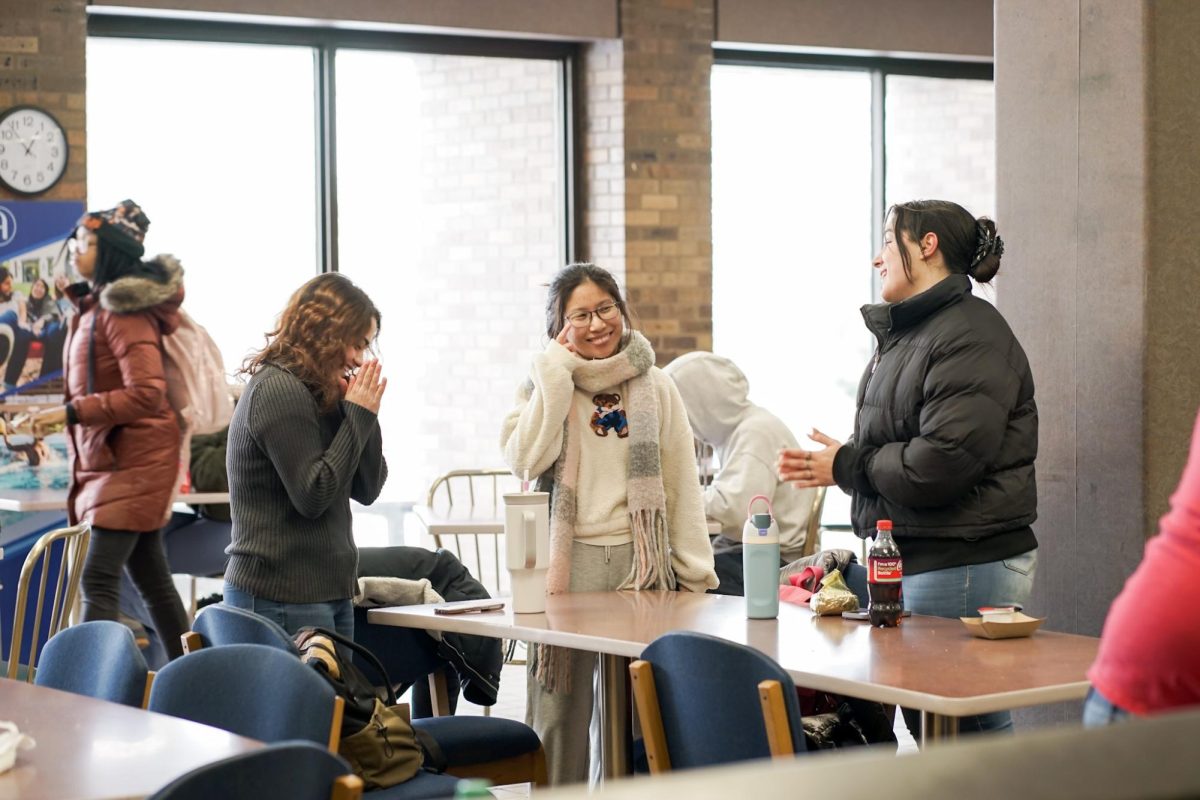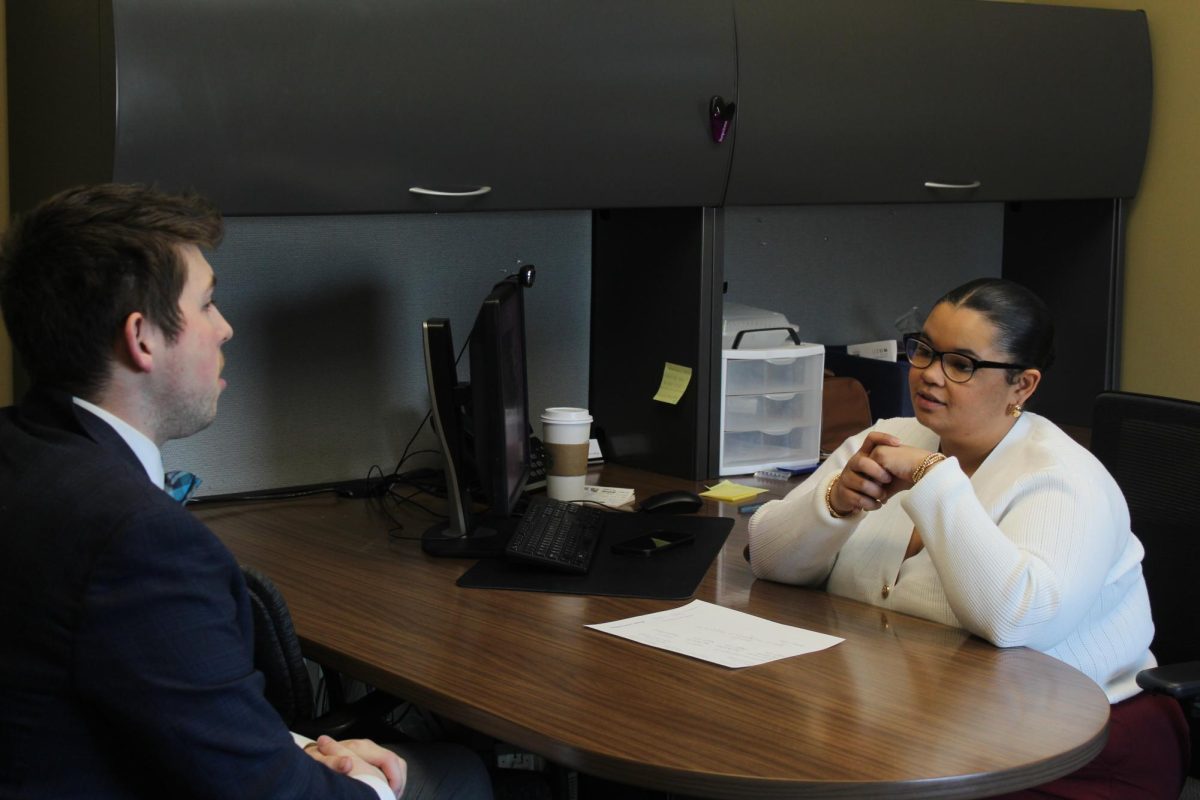Tires roll without reservation as professors and students zoom across campus during their daily commutes to classes. The various colors of bikes with the numerous selections of baskets and other components make them unique to their owner. The weather is beginning to stabilize in the cool temperatures of the sixties and seventies and more bikers can utilize the Quad Cities bike paths. Professors of all studies make their commute on two wheels.
“I do use my bike to commute to work, not in the winter, but in the fall and spring term I try to use a bike as much as I can,” Jane Simonsen, professor of history and gender studies said. “I live so close so I really don’t need to use the car.” Simonsen is not the only professor to use a bike as her main source of transportation to work.
Dr. Tim Muir, professor of biology, will use his bike every day for transport unless the weather causes the roads to become filled with snow or covered in ice, then Muir will just walk. Muir only lives around two miles away and Simonsen travels around seven miles round trip each day from Davenport.
Dr. Olivia Williams, professor of environmental studies, lives in downtown Davenport and will travel to campus on her bike and will also travel to other events a few miles away from her house. Williams has only been here for a year but she has been riding for the last eight years.
“I get VIP parking, I can either park it in my office or the bike rack right outside of Gerber,” Jacob Romaniello, English language learner specialist said. “I don’t ever have to worry about parking and when I live less than a mile away it seems like just a waste to have to get into a vehicle and drive.” Romaniello also uses his bike as transport to the grocery store like Hy-Vee or Aldi’s. The bike has a hitch on it so that his daughter can travel with him on bike paths.
Robert Wengronowitz, professor of sociology, mentions that he rides his bike 90% of the time and will ride it more now that the snow is going away.
Dr. Greg Domski, professor of chemistry, uses his bike for transportation but also to exercise with forty mile training rides. Domski also rides century some weekends as well as compete in the annual great ride across Iowa.
Jim van Howe, professor of physics and astronomy, started to use a bike for exercise after too many running-related injuries. “The larger reason for biking to work, however, was to lower our family’s carbon footprint, waste less, and to save money,” Howe said.
Muir originally used a bike to save costs of buying a second car, but it wasn’t long after that he started to enjoy riding the bike to work. Domski had a similar introduction to using a bike as the main source of transportation.
“I like being outside in the fresh air,” Simonsen said.
Williams rides for environmental reasons and because she says it is a lot of fun.
“I prefer to cycle because in my mind it is more efficient, “Romaniello said. “It is kind of like setting the reset button.”
Even with all the perks of being environmental friendly, saving money, and gaining exercise the bicycle still faces some struggles.
“If it is snowy or icy I don’t ride my bike,” Simonsen said. “I’m just too old now. I use to ride in extreme weather a few times in my life but I am not that person anymore.”
Domski mentions that the salt thrown all over the roads during the winter months can actually eat away at the bike’s gears and other small components. Domski recommends using a single speed bike during this time to avoid having to continue to replace the components every year.
Romaniello has a Norwegian friend who had his tires studded to maintain traction in the winter and Romaniello doesn’t think he has to get that hardcore yet. Howe recently had his bike fitted with studded tires for this last winter. Yet, even Howe mentions that no matter how safe your bike is there is always danger.
“However, even if my own tires stick to the road I am sometimes too nervous about cars,” Howe said. “Also, so many people text and drive or are distracted in other ways in their cars.”
Lucas Street. director of the reading/writing center, was hit from behind by a car two months ago and since became a more defensive cyclist.
“I now avoid busy streets altogether, despite the fact that cars are legally required to share the road and to yield to cyclists just as they would other vehicles,” Street said. “And I always wear a helmet-mine absolutely saved my life that day.”
Romaniello saw the whole accident because Street was outside his house. Romaniello never wore a helmet before but after hearing it was what saved Street’s life he has since started to wear one on every ride. Romaniello can see people on their phones while he passes by their large SUVs and that makes him rather anxious while riding on the roads.
“I’m not invisible and I don’t want to get hit by somebody opening their car doors,” Romaniello said. “I wish people realize that one more bike on the street is one less car.”
Romaniello mentions that driving a car can cause people to zone out and riding a bike will create a different experience.
“I think it connects me more to the present moment,” Romaniello said. “When you are cycling you have to be in the present moment. I can appreciate my surroundings.”
Both Romaniello and Simonsen have traveled to other nations and found that the bike culture is a lot different than America.
“It makes me feel sad,” Simonsen said. “I lived mostly in Germany and studied in Europe. I used my bike more extensively over in Europe. We felt safe with our children riding on the streets there.”
Simonsen mentions that the bike paths had signal lights and the U.S. has made it more difficult to bike compared to Europe. Simonsen’s schedule in Europe was really flexible compared to the American lifestyle.
“There is a certain speed in our lifestyle here that make it hard to bike,” Simenson said.
Romaniello noticed while living in Thailand that people there grew up on motorbikes. The use of motorbikes was used more out of a necessity and here in America, it is more to a point of convenience.
“They just have this eternal awareness of other people who are exposed and not protected by the vehicles we have here,” Romaniello said.
Howe mentions that the reason America is so different with its biking culture is that the housing and economy is established around owning an automobile. Other parts of the world people live in dense areas where gas is expensive and public transportation and biking are more attractive.
“The U.S. has such a car culture, and despite a large devoted cycling contingent in the Quad Cities, there’s not great infrastructure for cyclists,” Street said.
Jason Pacanowski, junior, mentions that it could be because Americans are lazy and would like to use motor transportation all the time.
Pacanowski does not use his bike to get classes but will use it to get around outside of class hours and to get around locally.
“It’s also a good way to see more and go farther when I ride on a trail, as I’ve never been a fan of distance running,” Pacanowski said.
Mikaylo Kelly, sophomore, uses his bike to get around campus and to “burst out of the Augie bubble”.
“I enjoyed the freedom and I continue to enjoy the freedom,” Kelly said.
Dr. Kurt Christoffel, professor of chemistry, mentions that Global Affect ran a program called Viking Bikes. The program began with four bikes that were lent out to students.
“However, essentially from the outset they had no mechanism to enforce offenders to pay for damage to or loss of the bicycles,” Christoffel said. The program also relied on campus staff to provide oversight, who had other duties. Bikes were brought after business hours and about one to two bikes were lost every year according to Christoffel. Christoffel says that it seemed like there was no longer any student interest because those that ran the program left.
Domski, Muir, and Simonsen believe that since campus is already dense and mostly hills that students would rather just walk. Although Domski mentions that he would love to have a solid group of students create a bicycle club for campus. Romaniello and the other professors find the bicycle an opportunity to gain more out of life.
“I find riding a bike being free,” Romaniello said.
Photo above: Jane Simonsen, professor of history and gender studies, is arriving to work on her bicycle. Simonsen will ride to work all the time unless ice gets in her way. Photo by Brady Johnson.
Categories:
Cycling in the Quad Cities: community on two wheels
April 26, 2018
Jane Simonsen, professor of history and gender studies, is arriving to work on her bicycle. Simonsen will ride to work all the time unless ice gets in her way. Photo by Brady Johnson.
0
More to Discover










































































































